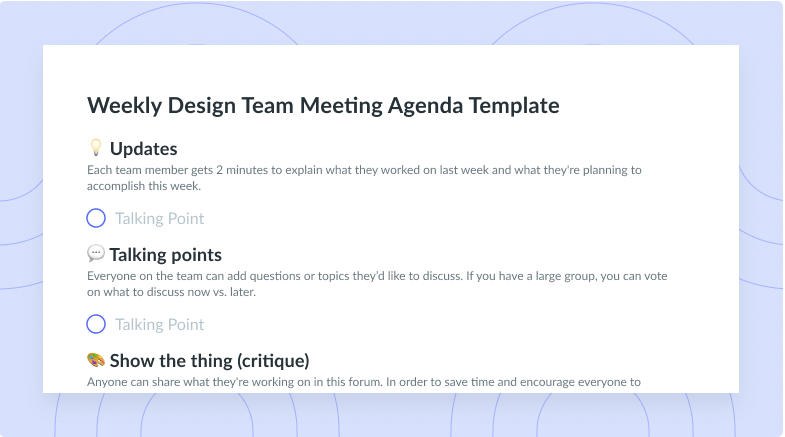
SOAR Analysis Template
Get this templateUse this framework to analyze your organization's current strengths and opportunities, discuss aspirations for the future and the results needed to reach those goals.


“SOAR is a strategic planning framework with an approach that focuses on strengths and seeks to understand the whole system by including the voices of the relevant stakeholders. SOAR conversations center on what an organization is doing right, what skills could be enhanced, and what is compelling to those who have a ‘stake’ in the organization’s success.”
(Stavros, J. & Hinrichs, G. (2009). The thin book of SOAR: Building strengths-based strategy.)
SOAR Analysis Overview
SOAR stands for Strengths, Opportunities, Aspirations, and Results, and it’s crucial to the well-being of a company and its employees to regularly explore a SOAR analysis. Overall, SOAR is a strategic planning tool that all companies should focus on developing. SOAR allows businesses to focus on their current strengths while building a vision for the future through strategic goal setting.
The purpose of SOAR analysis is to determine the current company position while evaluating goals and aspirations, as well as the expected results from setting such goals. SOAR is a fantastic concept because it applies to everyone within the company, regardless of hierarchy. SOAR places a heavy focus on coming into alignment with company goals, so everyone can move in the right direction. In short, it creates a flow.
SOAR meetings should take place once a month, or once quarterly. It depends on the intricacy of the company’s vision. SOAR meeting attendees can include anyone that is invested in a particular company, ranging from management to entry-level employees. SOAR encompasses and applies to every person within a business.
SOAR meetings are crucial when it comes to providing direction, which is what most employees want. Everyone wants to know what they’re working toward, even if those goals are not their own, but part of a greater purpose.
How to Run an Effective SOAR Analysis Meeting
Running an effective SOAR meeting is so much easier when there’s access to a good SOAR analysis template. When those piloting the meeting can write down what they want to say and what components are the most important. A SOAR meeting should be inclusive, as it involves every person in the company.
Preparing for a SOAR meeting means taking a good look at company goals and whether or not the current path will end in meeting those goals. SOAR emphasizes the way companies are always evolving and changing and helps keep business owners and management on track with those changes.
If those scheduled to run a SOAR meeting are feeling stuck, it might help to search for SOAR analysis examples. It’s common to have a large company-wide audience for meetings such as these, so keeping everyone aligned is an essential component. It’s crucial to leave a question-and-answer opportunity open at the end of the meeting, so when filling out the template guide, ensure that there is time for that. Most people will have fantastic questions, and those questions are important to consider as company goals are consistently reevaluated.
What’s inside this SOAR Analysis Template:
1 💪 Strengths
In the strengths section of the template, companies will consider the strengths that are already in place that can be leveraged to help pursue goals. Meeting orchestrators can make strengths into a list of company know-how, resources, and critical assets. Think deeply about what makes this particular company unique, and what can be considered the unique selling point. What can this company do better than anyone else? Evaluate which of these listed strengths offers the most to the current marketplace. Go from there and be accepting of input.
2 💡 Opportunities
“When opportunity presents itself, don’t be afraid to go after it.” – Eddie Kennison
For this section, it’s time to take a look at the opportunities available in the industry that could make the company more successful. Some great questions to answer (and ask attendees) regarding opportunities focus on exploring which trends in the current market can be taken advantage of and considering turning threats into opportunities. If there are gaps in the existing market, think about what it might take to fill those gaps. Businesses find plenty of opportunities in SOAR meetings, but it’s important to remain open to ideas.
3 🚀 Aspirations
“If you don’t know where you are going, you will probably end up somewhere else.” – Lawrence J. Peter
Aspirations are all about the direction in which the company is headed. Company aspirations should be built on the strengths that have already been established, so if this section is initially difficult, the strengths section can act as guidance. Aspirations typically are not the same as an overall vision, but instead, represent achievements in the nearer future. For aspirations, consider what is genuinely cared about within the organization and focus on how that can make a difference. Overall, what is it that this business aims to achieve?
4📈 Results
The results section of the meeting should be less focused on results that have already happened as opposed to those expected once aspirations have been achieved. It’s also a great place to focus on how the company as a whole will track progress to ensure that they’re on the right road. Do not set too many tracking measurements, as it becomes overwhelming and stressful rather than helpful. Instead, focus on 3 to 5 values that are imperative to the success of the company, and consistently evaluate how to turn aspirations into something measurable. What numbers and statistics efficiently track that progress?
















